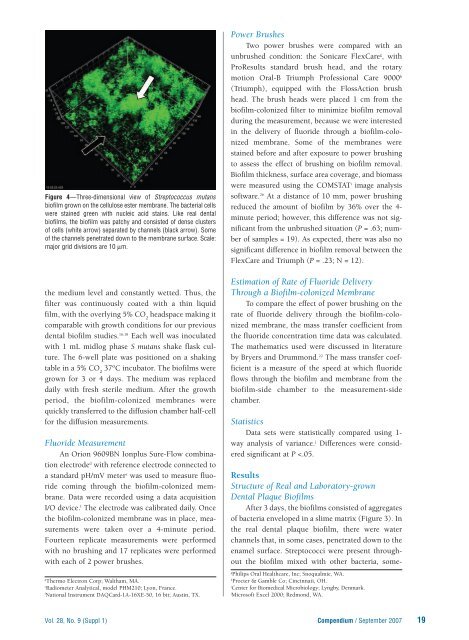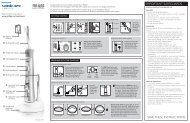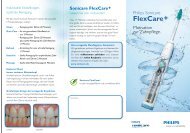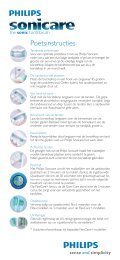Philips Sonicare FlexCare - Sonicare.com - Sonicare
Philips Sonicare FlexCare - Sonicare.com - Sonicare
Philips Sonicare FlexCare - Sonicare.com - Sonicare
You also want an ePaper? Increase the reach of your titles
YUMPU automatically turns print PDFs into web optimized ePapers that Google loves.
Figure 4—Three-dimensional view of Streptococcus mutans<br />
biofilm grown on the cellulose ester membrane. The bacterial cells<br />
were stained green with nucleic acid stains. Like real dental<br />
biofilms, the biofilm was patchy and consisted of dense clusters<br />
of cells (white arrow) separated by channels (black arrow). Some<br />
of the channels penetrated down to the membrane surface. Scale:<br />
major grid divisions are 10 µm.<br />
the medium level and constantly wetted. Thus, the<br />
filter was continuously coated with a thin liquid<br />
film, with the overlying 5% CO 2<br />
headspace making it<br />
<strong>com</strong>parable with growth conditions for our previous<br />
dental biofilm studies. 16,18 Each well was inoculated<br />
with 1 mL midlog phase S mutans shake flask culture.<br />
The 6-well plate was positioned on a shaking<br />
table in a 5% CO 2<br />
37ºC incubator. The biofilms were<br />
grown for 3 or 4 days. The medium was replaced<br />
daily with fresh sterile medium. After the growth<br />
period, the biofilm-colonized membranes were<br />
quickly transferred to the diffusion chamber half-cell<br />
for the diffusion measurements.<br />
Fluoride Measurement<br />
An Orion 9609BN Ionplus Sure-Flow <strong>com</strong>bination<br />
electrode d with reference electrode connected to<br />
a standard pH/mV meter e was used to measure fluoride<br />
<strong>com</strong>ing through the biofilm-colonized membrane.<br />
Data were recorded using a data acquisition<br />
I/O device. f The electrode was calibrated daily. Once<br />
the biofilm-colonized membrane was in place, measurements<br />
were taken over a 4-minute period.<br />
Fourteen replicate measurements were performed<br />
with no brushing and 17 replicates were performed<br />
with each of 2 power brushes.<br />
d<br />
Thermo Electron Corp; Waltham, MA.<br />
e<br />
Radiometer Analytical, model PHM210; Lyon, France.<br />
f<br />
National Instrument DAQCard-1A-16XE-50, 16 bit; Austin, TX.<br />
Power Brushes<br />
Two power brushes were <strong>com</strong>pared with an<br />
unbrushed condition: the <strong>Sonicare</strong> <strong>FlexCare</strong> g , with<br />
ProResults standard brush head, and the rotary<br />
motion Oral-B Triumph Professional Care 9000 h<br />
(Triumph), equipped with the FlossAction brush<br />
head. The brush heads were placed 1 cm from the<br />
biofilm-colonized filter to minimize biofilm removal<br />
during the measurement, because we were interested<br />
in the delivery of fluoride through a biofilm-colonized<br />
membrane. Some of the membranes were<br />
stained before and after exposure to power brushing<br />
to assess the effect of brushing on biofilm removal.<br />
Biofilm thickness, surface area coverage, and biomass<br />
were measured using the COMSTAT i image analysis<br />
software. 26 At a distance of 10 mm, power brushing<br />
reduced the amount of biofilm by 36% over the 4-<br />
minute period; however, this difference was not significant<br />
from the unbrushed situation (P = .63; number<br />
of samples = 19). As expected, there was also no<br />
significant difference in biofilm removal between the<br />
<strong>FlexCare</strong> and Triumph (P = .23; N = 12).<br />
Estimation of Rate of Fluoride Delivery<br />
Through a Biofilm-colonized Membrane<br />
To <strong>com</strong>pare the effect of power brushing on the<br />
rate of fluoride delivery through the biofilm-colonized<br />
membrane, the mass transfer coefficient from<br />
the fluoride concentration time data was calculated.<br />
The mathematics used were discussed in literature<br />
by Bryers and Drummond. 22 The mass transfer coefficient<br />
is a measure of the speed at which fluoride<br />
flows through the biofilm and membrane from the<br />
biofilm-side chamber to the measurement-side<br />
chamber.<br />
Statistics<br />
Data sets were statistically <strong>com</strong>pared using 1-<br />
way analysis of variance. j Differences were considered<br />
significant at P










